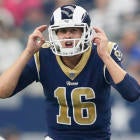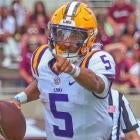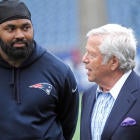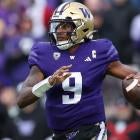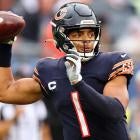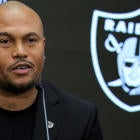If someone had told you prior to the start of the season that the Week 11 matchup between the Rams and Vikings would pit two powerhouse 7-2 contenders against each other to determine which has a leg up on a bid for a first-round playoff bye, the proper response would have been to assume that you'd just woken from years-long hibernation and ask what year it was.
Las Vegas oddsmakers set the line for Minnesota's 2017 win total at 8.5 wins, while Los Angeles was way down at 5.5 wins. Neither team was necessarily expected to make a playoff push, let alone a run at one of the top two seeds. Instead, both teams have shocked (or at least surprised) the football world -- they each currently sit one game behind the Philadelphia Eagles for the best record in the NFL.
Both teams are getting it done with strong play on both sides of the ball. The Rams are the top team in Football Outsiders' overall DVOA ratings, ranked 11th on offense and first on defense. They lead the NFL in points per game, 30-point games, and expressions of surprise at how young their coach is. The Vikings aren't far behind the Rams, checking in fifth in overall DVOA, seventh on offense, and ninth on defense. The Vikes having a strong point prevention unit is not a surprise, given the talent on hand and the coaching strengths of Mike Zimmer, but Case Keenum is leading a top-10 offense definitely qualifies as a shocker.
Still, the intrigue in a Rams-Vikings game undoubtedly lies in the matchup between Sean McVay's offense and Zimmer's defense. The Rams becoming a Greatest Show on Turf-style juggernaut that can rain points quicker than any team in the league is probably the biggest surprise of the season, and seeing it go up against one of football's stingiest defenses is going to be quite a lot of fun.
Only two teams stopped L.A. from scoring at least 27 points this season: Washington and Seattle. Only two teams have scored more than 20 on the Vikes: Pittsburgh and Washington.
It's not a coincidence that the two teams that slowed down the Rams each have strong cornerback play on both sides of the field and defensive lines that can get pressure without resorting to the blitz. Not surprisingly given their defensive prowess, the Vikings are a team just like that (Xavier Rhodes has been excellent for a while, and Trae Waynes has really come on over the last few weeks), and they also have one of the most athletic linebacker and safety groups in the league.
It's also not a coincidence that the two teams that pierced the Minnesota defense have passers that attack with throws deep down the field. Loosening up a defense over the top opens up the middle, the toughest area to cover. Fittingly, that has been one of Jared Goff's strengths this season; he's fourth in the NFL in passer rating on throws at least 20 yards downfield, per Pro Football Focus, a major leap forward from last year when he completed just 4 of 17 such passes.
McVay is scheming players open all over the field, but Goff has been at his most effective when attacking the middle of the defense. He's thrown 12 of his 16 touchdown passes and racked up 64 percent of his passing yards on throws to players between the painted numbers on the field.

The Vikings have defended passes to the deep middle very effectively -- no surprise with Harrison Smith lurking on the back end of the defense. He's having one of his best seasons. Where you've been able to attack them over the middle is with shorter passes, but even those have not yielded much in the way of big gains. The Vikings will allow you to complete those passes, but they rally to the ball and tackle as well or better than any defense in the league. Tight ends and slot receivers have been able to rack up targets and catch totals against the Vikes, but have not broken free for big yardage.
But the Rams don't really attack the middle with those types of players -- they mostly do it by getting their outside receivers working across the field or up the seams. Slot man Cooper Kupp actually only has 18 catches when lined up in the slot. He's got 14 when lined up outside. L.A.'s tight ends aren't intimately involved in the offense, and Tavon Austin has become exclusively a gadget player. Instead, the Rams run Robert Woods, Sammy Watkins, and whoever else lines up on the outside through lot of slants, posts, and crossers, oftentimes in combination with each other in order to make linebackers and safeties decide which threat is greater, then let Goff read the defender and make the correct call on where to throw.
They'll also sneak Todd Gurley out of the backfield on pivot routes in order to give Goff a second underneath option on occasion. Most running back routes are to the outside when the player comes out of the backfield because that's safer for check-downs, but you can catch the defense leaning the wrong way if you send the back on a route that looks like it's headed to the outside, only for him to snap it off back towards the middle.
The design of all these route combinations is the key -- McVay is opening up the widest possible lanes for Goff to throw through. According to the NextGen Stats on NFL.com, Goff makes fewer throws into tight windows than any other passer in the league. This should not be a surprise for the quarterback of a McVay-led offense; Kirk Cousins made the second-fewest tight window throws last season, when McVay was his offensive coordinator in Washington. By the way, Goff made the third-most tight window throws last season. So, yeah, McVay is making an impact.
Of course, you can't make throws into any window if you're not well-protected. Goff faced pressure on 44 percent of his dropbacks last season, per Pro Football Focus, the third-highest rate among 37 qualified passers. This season, he's only been pressured 34 percent of the time. Just like every other quarterback in the league, he's better when throwing from a clean pocket (110.0 passer rating compared to 82.3 when pressured), so the better protection has been a boon for his numbers. A lot of the credit has to go to free agent signings Andrew Whitworth and John Sullivan, who have stabilized what was previously one of the worst lines in the NFL.
They'll have their hands full on Sunday, especially if Everson Griffen suits up despite his week of limited practices. (He says he's ready to play.) The Vikes can get pressure by rushing only four, but they do their best work when bringing targeted blitzes. Anthony Barr, Eric Kendricks, and Harrison Smith are all extremely effective when Zimmer unleashes them in the rush. Minnesota's pressure rate shoots up from 34 percent to 42 percent when bringing five rushers instead of four, and skyrockets to 62 percent when they send six guys after the quarterback.
If the Rams can hold up in protection and give Goff adequate time, McVay will figure out a way to open up those wide throwing windows over the middle of the field eventually. It's up to Goff to exploit them. He's running up against a tough challenge in one of the better defenses in the league this Sunday. The last time that happened (against Seattle), he struggled. Whether he can show that he's taken a step forward will go a long way toward determining whether his team gains firmer footing in the race for one of the top seeds in the NFC, or falls back toward the pack.













